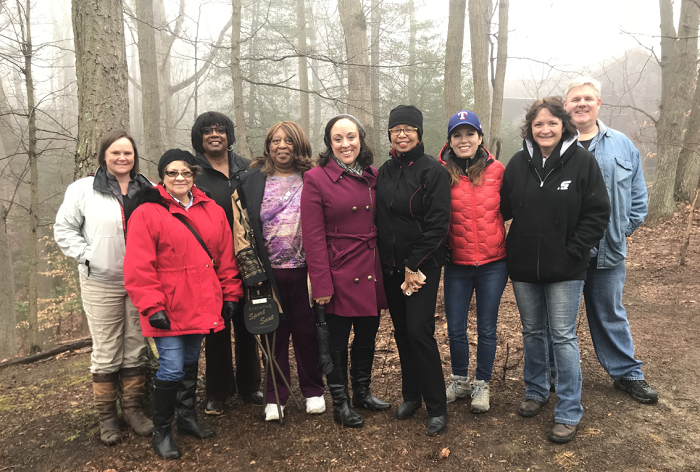
MDOT SHA Logo
Slave Cemetery Located on Former Tobacco Plantation
(March 6, 2018) – On a late-January day, Maryland Department of Transportation (MDOT SHA) Archaeologists were shown something sacred within a forest surrounded by snarled cedar stumps; field stones, perhaps marking old graves, dotted the surface. A white marble headstone, broken in two, was desecrated here. Although the name and date on this stone were eroded away by time and elements, archaeologists suspect that it may have belonged to a 4-year old African American boy, Joseph Grocia, who was buried somewhere on the property in 1913.
The cemetery find is located on a tract of land known as Belvoir, a plantation owned by relatives of Francis Scott Key, the writer of our National Anthem from the War of 1812. Belvoir was a historic tobacco plantation outside of Annapolis where a rare, stone slave quarter was excavated by Anne Arundel County and MDOT SHA archaeologists as part of a Transportation Enhancement Project. They did not know about the burial ground, until now. The property is now owned and maintained by Rockbridge Academy in Crownsville.

(MDOT SHA photo: Area thought to be a Historic Slave Cemetery Located on Former Tobacco Plantation.)
Two gentlemen, Rodney Daff and James Brown Jr., who grew up on the Belvoir plantation in the 1970s when the property was covered in strawberry fields, reached out to MDOT SHA Chief Archaeologist Dr. Julie Schablitsky. James’ dad shared the history of the plantation with the boys and told them about the “slave cemetery.”
“When we walked to the flat point of land I became very excited about what I saw,” said Dr. Schablitsky. “I could tell right away that this was a sacred place that had been lost to time, but we needed more evidence that it was used as a burial ground.”
To help confirm the oral history of this space being used as a “slave cemetery”, MDOT SHA enlisted the help of Heather Roche, with Bay Area Recovery Canines, who visited the site last weekend to help determine if human remains were buried at the site. The dogs are trained to detect the scent of human decomposition, even after 200 years in the ground.
All three of the canines indicated the presence of human remains.
“The topography and location, along with the pattern of field stones and indications by Roche’s K9 team, are compelling pieces of evidence to indicate that this is, in fact, a long-forgotten cemetery related to residents of the Belvoir plantation,” said Anne Arundel County Chief of Cultural Resources Jane Cox. “The discovery offers tremendous potential to learn about an often-under-represented part of our county’s history.”

(MDOT SHA photo: (left to right) - Jane Cox - Chief, Cultural Resources Section, Anne Arundel County, Shelley Evans - Descendant, Pam Brogden - Descendant, Nancy Daniels - Descendant, Erica Jones - Descendant, Wanda Watts - Descendant, Julie Schablitsky - MDOT SHA Chief Archaeologist, Kim Franklin - Local resident, and Rodney Daff - Local resident.)
Further study would still be needed to determine the date of the burials and whose relatives may rest there. Despite the cautious optimism by the archaeologists, the descendants of the African American community at Belvoir are excited about the potential.
“As descendants of enslaved families that lived on Belvoir Plantation we are thrilled to have this access and knowledge of our history in Crownsville, Maryland,” said Wanda Watts. “Not many African Americans are connected to the heritage of their ancestors as we are,” said Watts.
MDOT SHA and Anne Arundel County archaeologists partnered in the discovery of historic sites along General's Highway, where Civil War sites, homes, and Native American camps lay buried. Along this corridor, Rochambeau’s troop of 5,000 soldiers camped at Belvoir on their way to the Battle of Yorktown, which effectively ended the American Revolutionary War. Additionally, Francis Scott Key spent time at the plantation with his grandmother Anne Arnold Ross Key. The archaeological findings will help interpret the use and evolution of this transportation corridor. The team began work at Belvoir in April 2014 and are currently writing up their finds. The African American community, county, and state have come together to recognize the lives of the enslaved people who lived and worked at Belvoir.
###